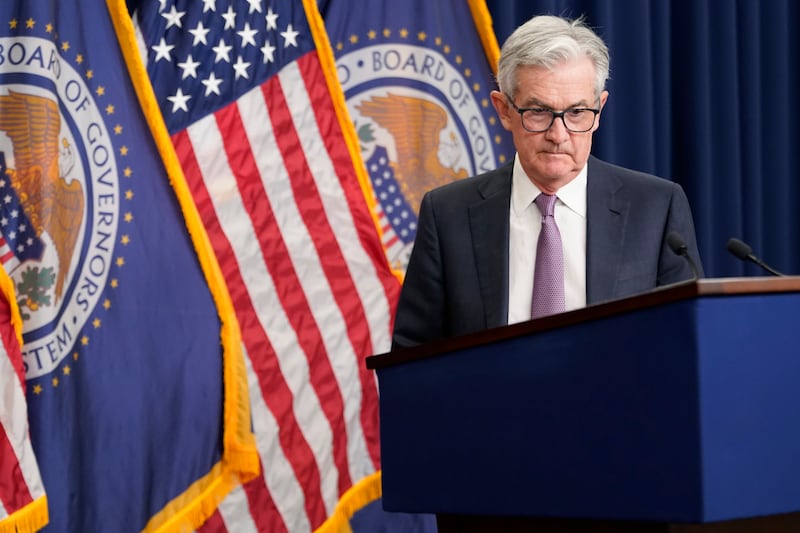As was widely expected, the Federal Reserve on Wednesday announced a .75% hike to its benchmark interest rate, marking the third increase of that size since June and the fourth overall rate bump this year.
The frequency and size of the rate increases are the fastest in decades and part of the Fed’s aggressive strategy to quell persistent, record-high U.S. inflation. While the tactic is already showing signs of pushing up the cost of consumer debt, an outcome the Fed favors in its attempts to reduce overall consumer demand, some economists worry the approach will push the U.S. economy into recessionary conditions.
Fed officials also forecast that they will boost their benchmark rate to roughly 4.4% by year’s end from its current 3% to 3.25% range, a full percentage point higher than they had forecast in June. And they expect to raise the rate further next year to about 4.6%. That would be the highest level since 2007.
Rates that high would be well into what the Fed calls “restrictive” territory, meaning they would be intended to sharply slow borrowing and spending, cool hiring and wage growth and defeat high inflation.
Fed officials have said they’re seeking a “soft landing,” by which they would manage to slow growth enough to tame inflation but not so much as to trigger a recession. Yet economists increasingly say they think the Fed’s steep rate hikes will lead, over time, to job cuts, rising unemployment and a full-blown recession late this year or early next year.
How does higher interest impact inflation?
The Fed rate hikes are intended to increase the cost of debt, a way to help cool consumer spending and, ultimately, bring down inflation by addressing demand. And, in some respects, those efforts are bearing fruit.
Last week, mortgage rates crossed the 6% threshold and hit their highest point since 2008, upping the pressure on the U.S. housing market and pricing out even more would-be homebuyers.
Freddie Mac predicts the high rates will continue to temper demand across the U.S. Although home for-sale inventory is rising, it still remains at “inadequate” levels, meaning home price declines will likely continue — but not fall off a cliff.
And, the average interest rate on credit cards hit 17.96% this month, the highest rate since 1996 according to Bankrate.com.
Bankrate senior industry analyst Ted Rossman told MarketWatch that for those carrying credit card debt, this means your rate could fluctuate as a result.
“Rate hikes generally affect new and existing balances,” Rossman said, adding that “most credit cardholders are currently facing rates that are 225 basis points higher than they were just six months ago.”

Is the Fed strategy working?
But, while the cost of a mortgage and accruing consumer debt on a credit card is on the rise, which are just the kind of results the Fed is hoping to see, other consumer trends are offsetting the dampening effect of rate increases.
Those factors include a U.S. job market that continues to run red-hot and still-robust consumer spending.
Employers added 315,000 jobs in August according to the latest U.S. Labor Department report and the national unemployment rate ticked up to 3.7% from a 50-year-low 3.5% in July. Hiring was down from July’s mammoth 526,000 new hires but the August volume is still well above pre-pandemic rates, and job listings still far outnumber the available workers to fill them.
Labor Department data shows eight of 13 retail spending categories rose in August, per CNN. Spending at food and beverage retailers was up 0.5% for the month and has risen by 7.2% over the past year. Sales increased at restaurants and bars as well as car dealerships jumped by 2.8% on the month. Spending on building materials and equipment, clothing and sporting goods also rose.
Is the U.S. economy headed for a recession?
As the Fed convenes on Wednesday, the disjointed economic signals will fuel another big rate boost but Powell noted at the Jackson Hole conclave that “our decision at the September meeting will depend on the totality of the incoming data and the evolving outlook.”
While interest rates on consumer debt look likely to continue their escalation amid further Fed increases, there is also the looming prospect that the strategy could push the U.S. economy into a prolonged economic downturn, aka, recession.
Last week, billionaire CEO Barry Sternlicht told CNBC that the U.S. economy is teetering on the brink of a serious downturn if the Federal Reserve doesn’t pump the brakes on its rate hikes.
Sternlicht said the Fed reacted too slowly when the first signs of inflationary upticks appeared and was now being overly aggressive in an effort to catch up.
“The economy is braking hard,” the chairman and CEO of Starwood Capital Group told CNBC’s “Squawk Box” on Thursday. “If the Fed keeps this up they are going to have a serious recession and people will lose their jobs.”
Contributing: Associated Press


